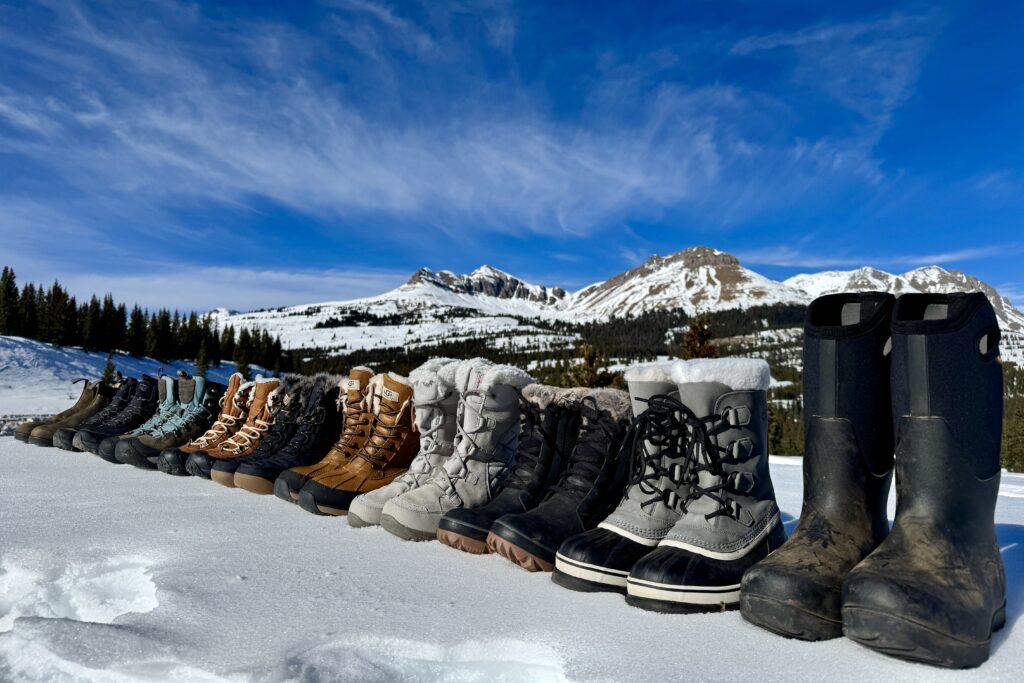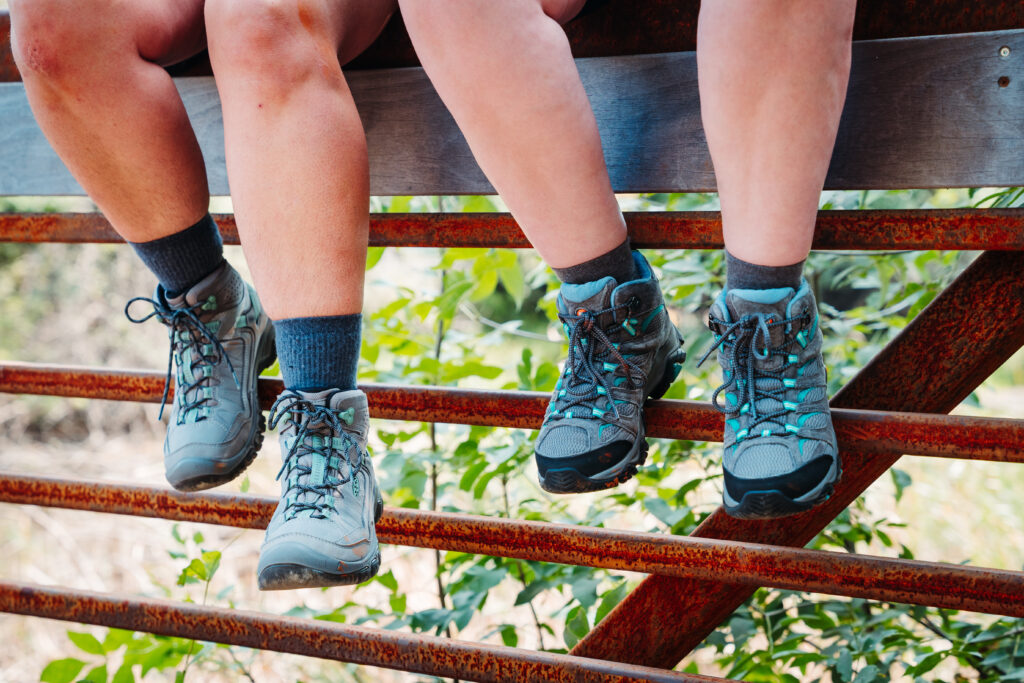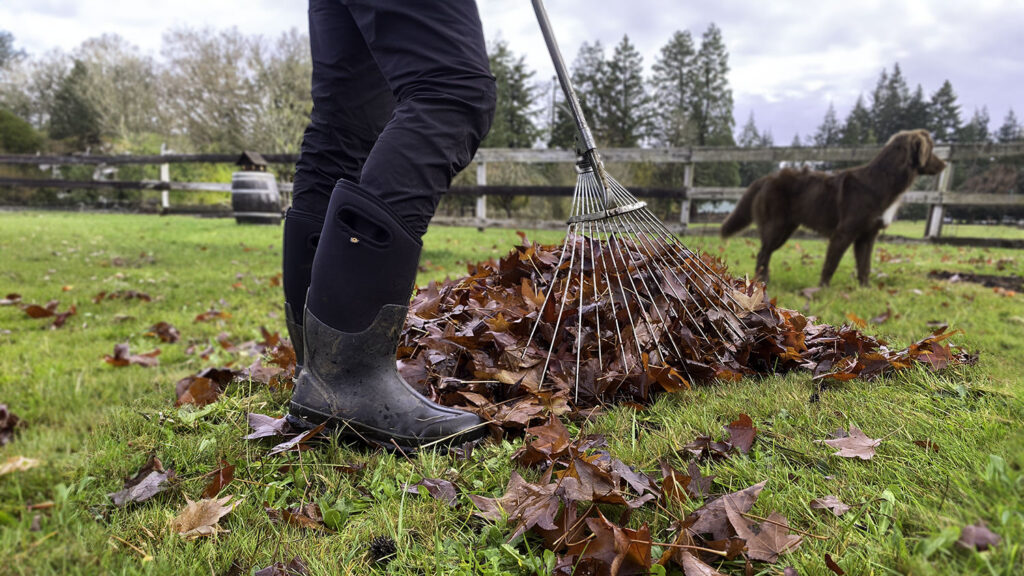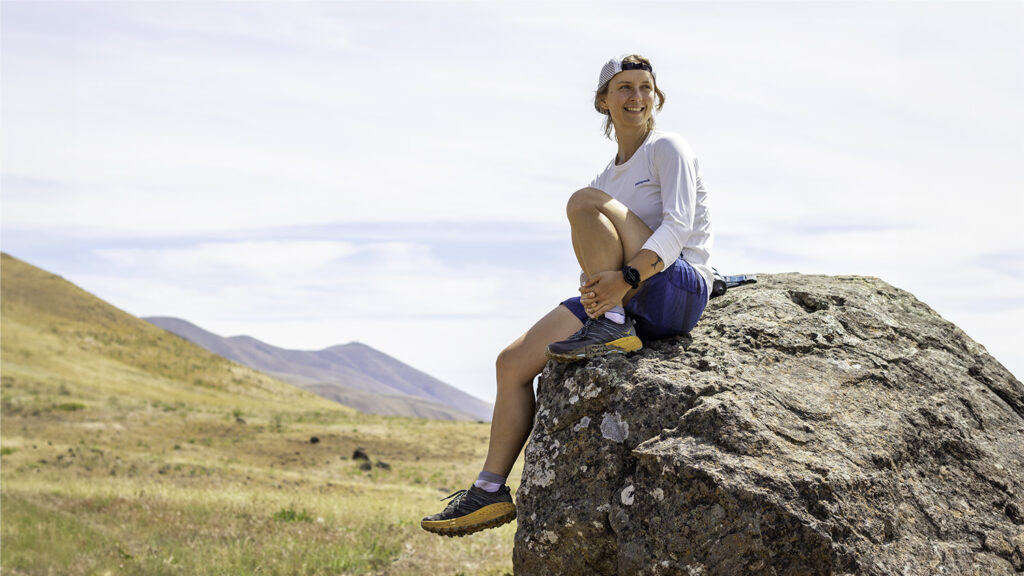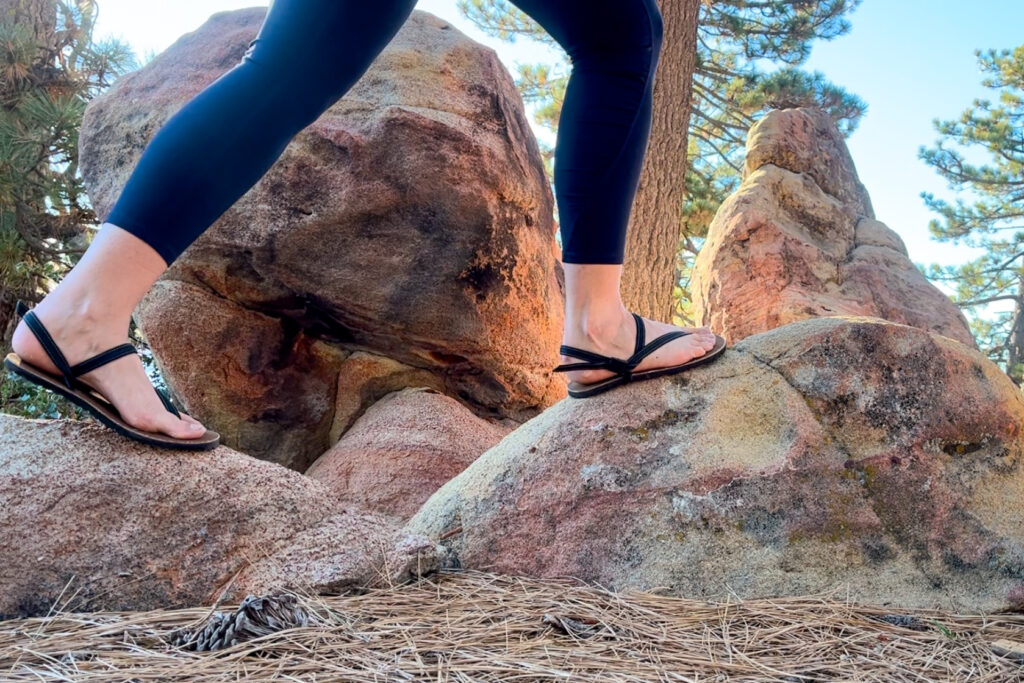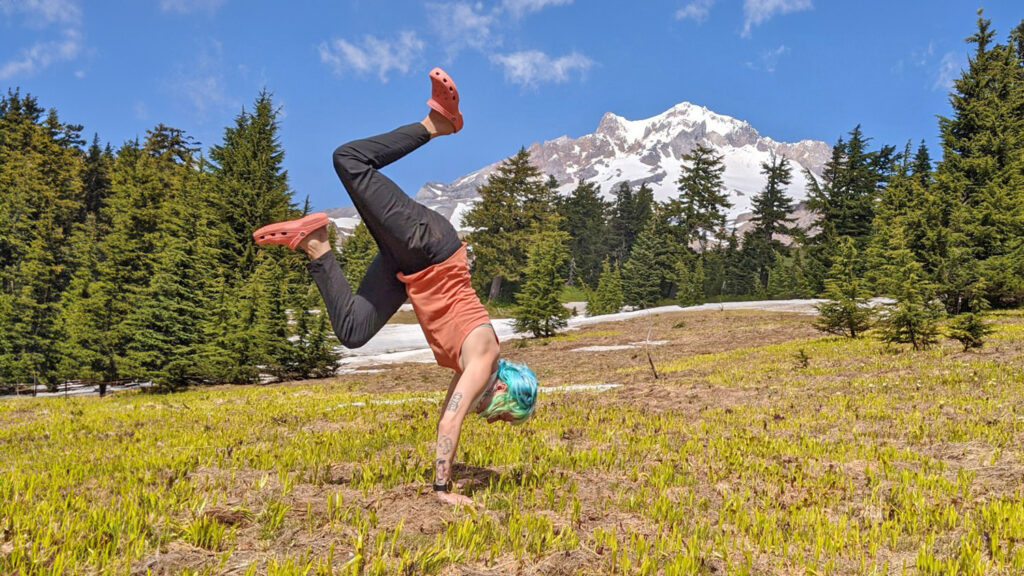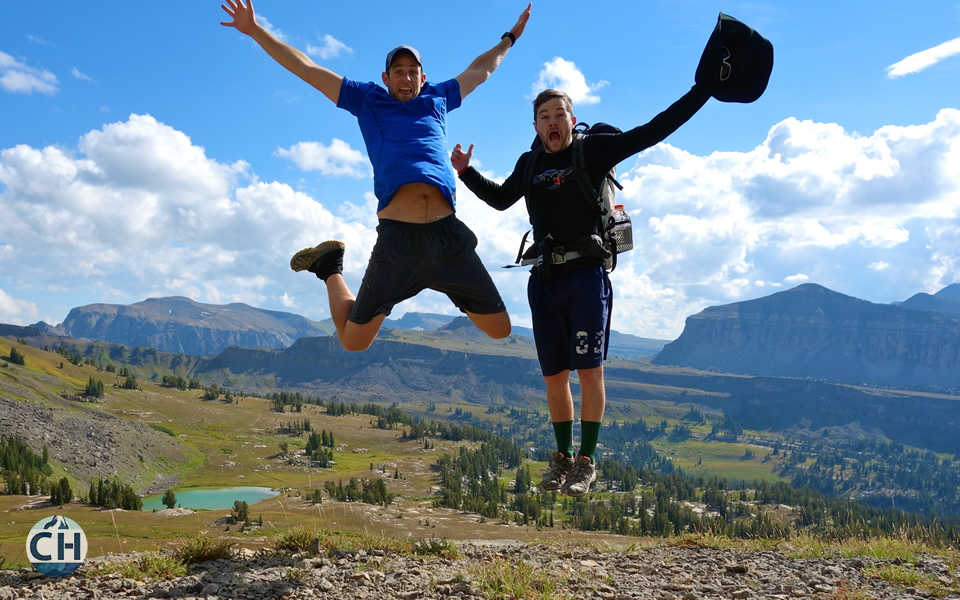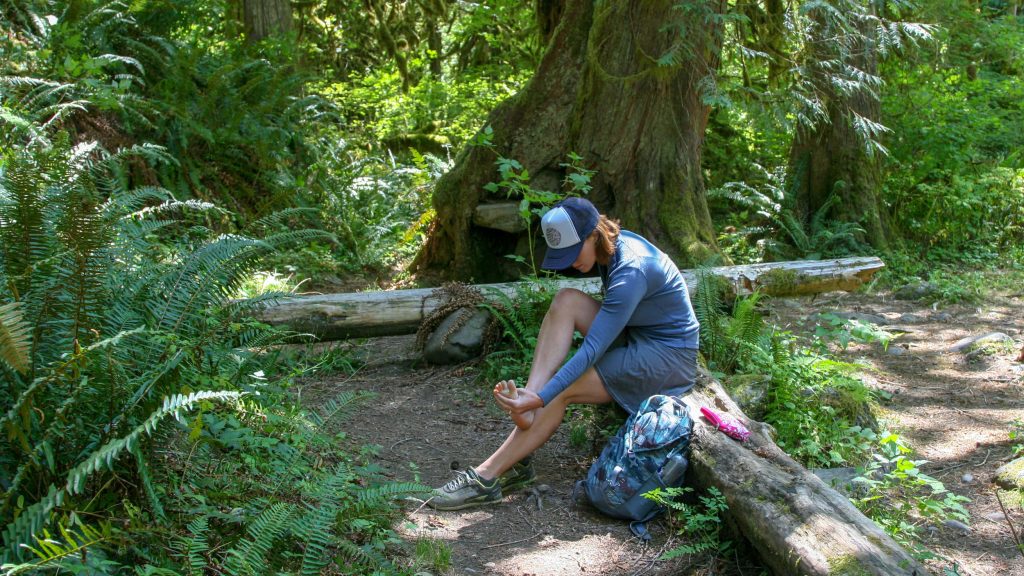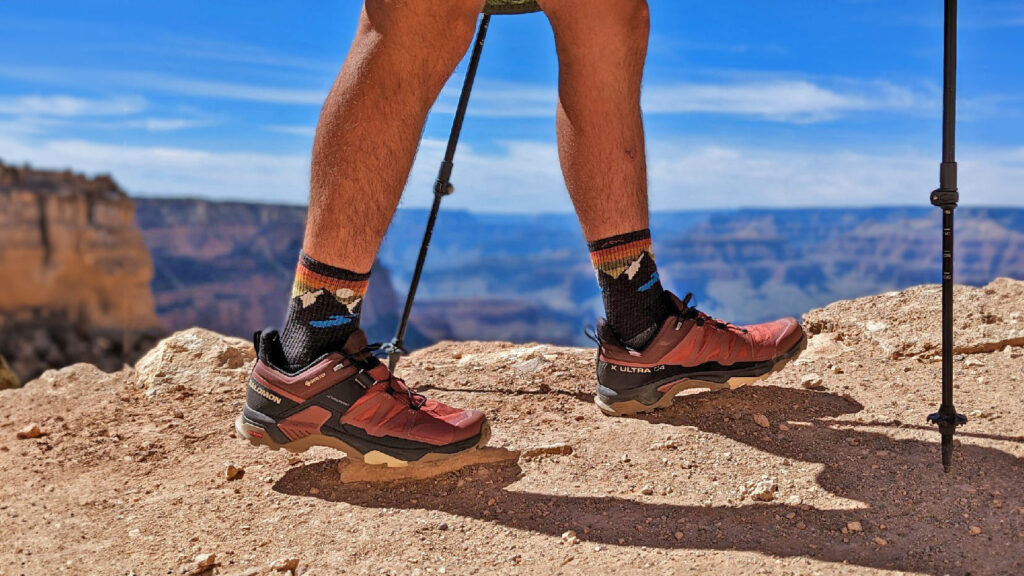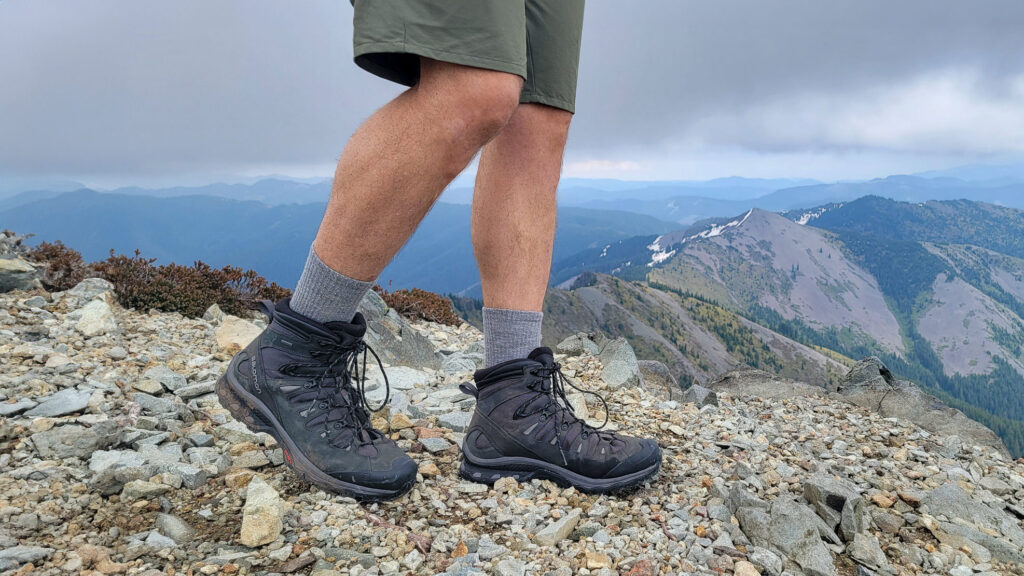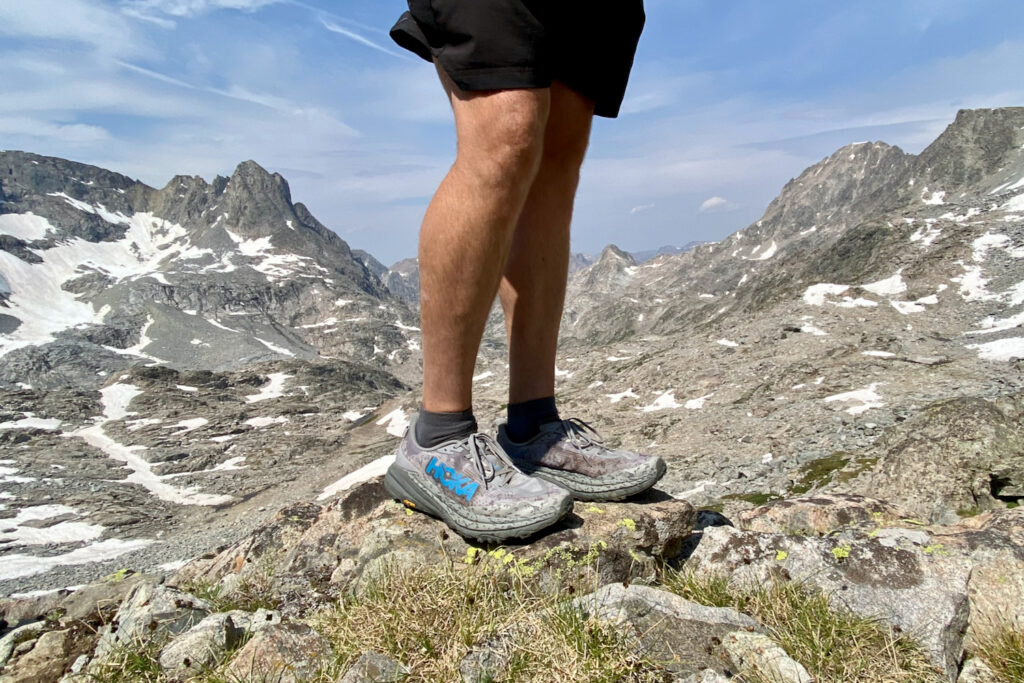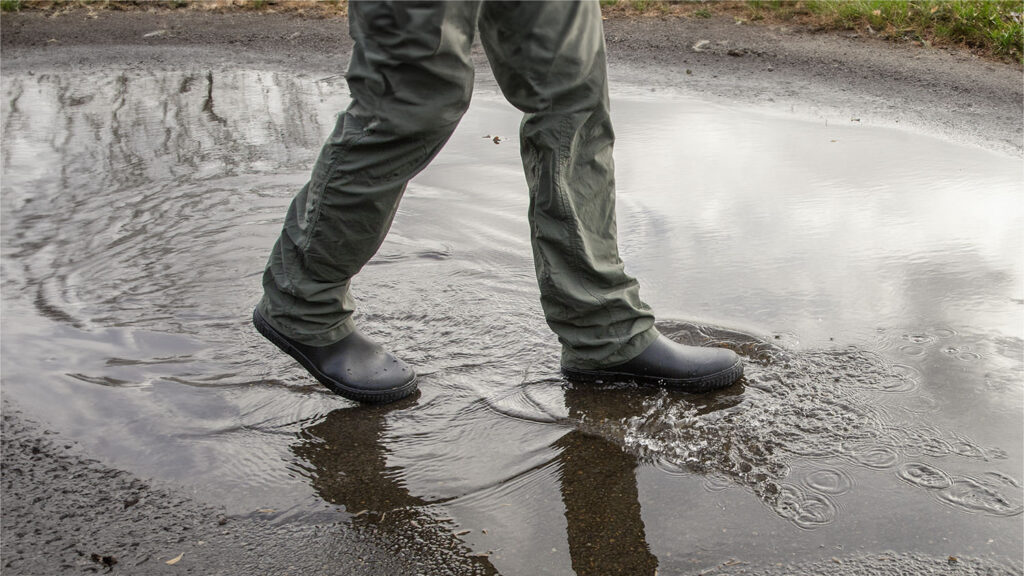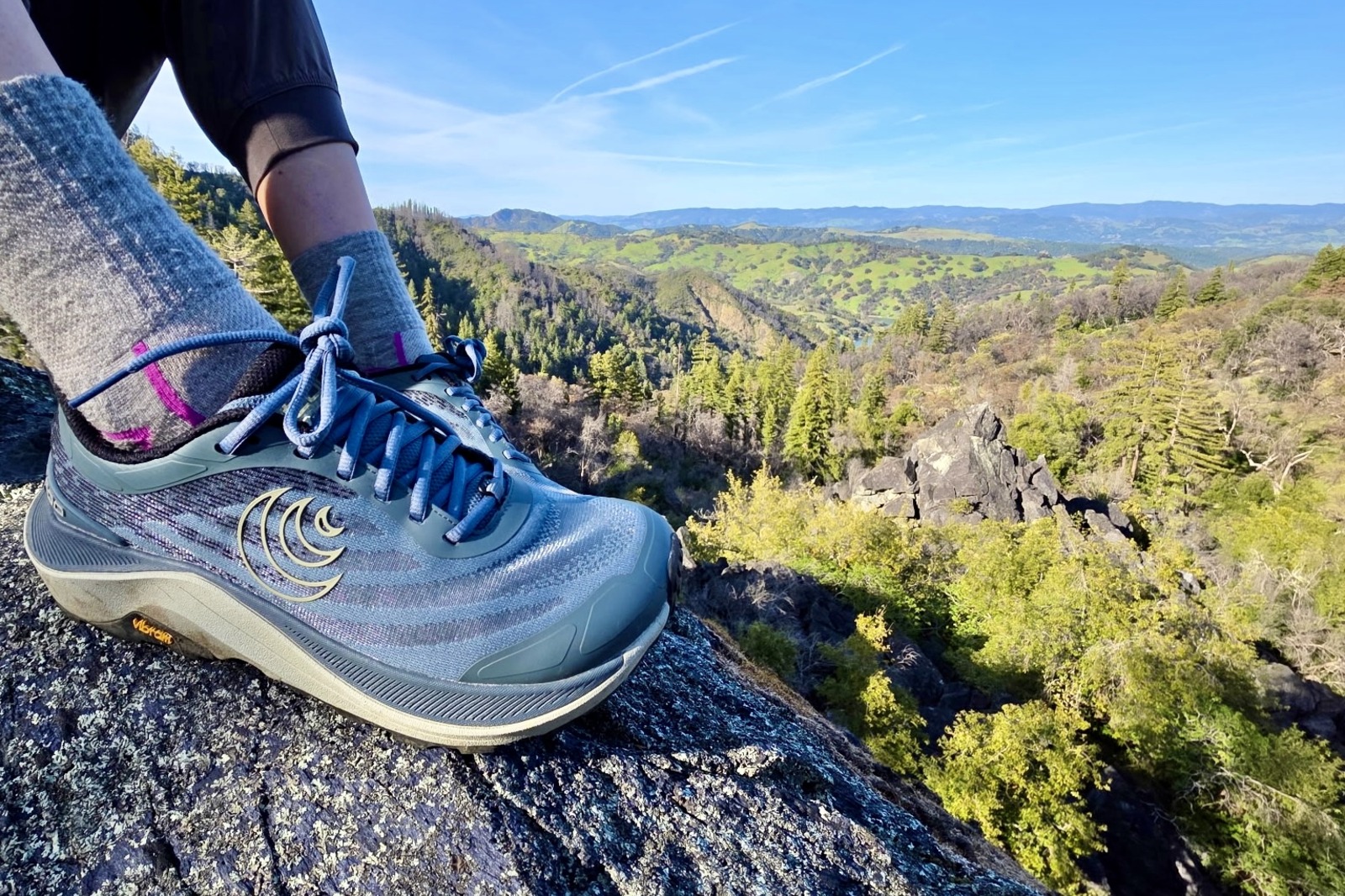
Choosing a great pair of hiking shoes is one of the most important gear decisions you’ll make. Finding the right balance of comfort, traction, weight, durability, and weather resistance will make a huge difference with every step along the trail.
Our team trail tested over 50 pairs of hiking shoes all over the world. From multiple 2000+ mile thru-hikes on the CDT and PCT to quick day hikes, we’ve put the best hiking shoes from brands like HOKA, Merrell, Altra, Salomon, Saucony, and more through the wringer to narrow down this list of our top picks.
If you need more support, durability, or weather resistance, you should also take a look at our list of the best hiking boots for women.
And for more info, check out some of our other most popular gear guides:
Quick Picks for Women’s Hiking Shoes
Check out this quick list of our favorite hiking shoes, or continue scrolling to see our full list with in-depth reviews.
Best Women’s Hiking Shoe Overall: Salomon X Ultra 4 Low ($140)
Best Hiking Shoes for Long-Distance & Thru-Hikers: Altra Lone Peak 9 ($140)
Best Lightweight Shoes for Hiking: Saucony Peregrine 15 ($140)
Best Hiking Shoes for Weight, Support & Breathability: Topo Athletic Ultraventure 4 ($150)
Hiking Shoes with A Lot of Cushion: HOKA Speedgoat 6 ($155)
Excellent for Style, Weight, & Durability: Merrell Moab Speed 2 ($140)
Best Budget Hiking Shoes: Merrell Moab 3 ($120)
Best Waterproof Hiking Shoes: La Sportiva Spire GTX ($209)
Excellent Value Hiking Shoes for Day Hikers: KEEN Targhee IV WP ($160)
Solid Minimalist Hiking Shoes: Xero Shoes Trail Scrambler Low WP ($150)
Highly Supportive Hiking Shoes That Hold Up to Hard Use: Oboz Sawtooth X WP ($165)
What’s New
Some new shoes and updates on favorites have hit the market this year, and we’ve been putting them to the test to see how they stack up against our top picks:
- The Salomon X Ultra 4 Low takes our top spot with responsive cushioning, increased durability, traction, and out-of-the-box comfort.
- The Saucony Peregrine 15 comes with enhanced traction and durability, making it faster and more efficient on rugged trails.
- The Altra Lone Peak 9 stands its ground as our top dog for thru-hiking with better durability, a more streamlined fit, and increased responsiveness underfoot.
- The Xero Shoes Scrambler Trail Low WP is a new addition to our gear guide, as a solid all-weather option for barefoot/minimalist hiking enthusiasts.
Women’s Hiking Shoes Overall Testing Scores
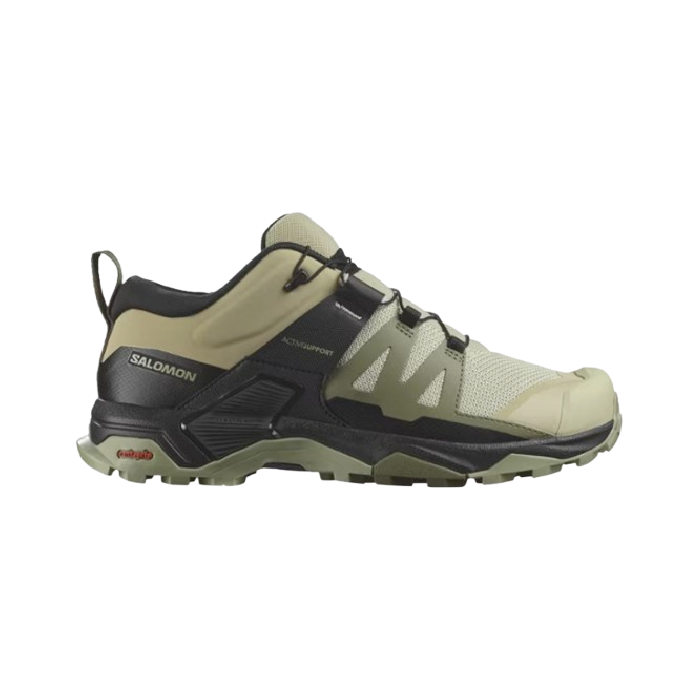
Women’s Salomon X Ultra 4 Low
Best Women’s Hiking Shoes Overall
CleverHiker Rating: 4.8/5.0
Price: $140
Weight (Pair): 1 lb. 6.4 oz.
Heel-to-Toe Drop: 11 mm
Pros
- Lightweight for how durable/supportive they are
- Very little break-in needed
- Excellent traction
- Breathable
- Stable
- Wide sizes available
- Quick Lace System offers a snug fit
Cons
- Not as durable for off-trail use
- Quick Lace System takes getting used to
The Salomon X Ultra 4 Low hiking shoes have a nearly unrivaled balance of durability and low weight – they’re built like a traditional shoe but they fit more like trail runners. These shoes feel much more nimble than others in their category, and they require practically no break-in period. After several hundred miles of testing – including 100 on the rugged Arizona Trail – we’ve found that the traction is well above average on the X Ultras, so they’re great for backpacking or day hikes on challenging terrain.
We’ve used every iteration of the X Ultras since the originals came out, and this most recent version delivers. With a narrow and snug heel cup that opens up to a slightly wider toe box, this version has a secure fit that provides confidence on the trail. Hikers who like a locked-in feel will likely appreciate this new design.
We’re big fans of the X Ultra line for its durability, balance of weight/support, and top-tier traction on variable terrain. So we highly recommend them for hikers wanting a shoe that fits like a trail runner but lasts as long as more traditional hiking footwear.
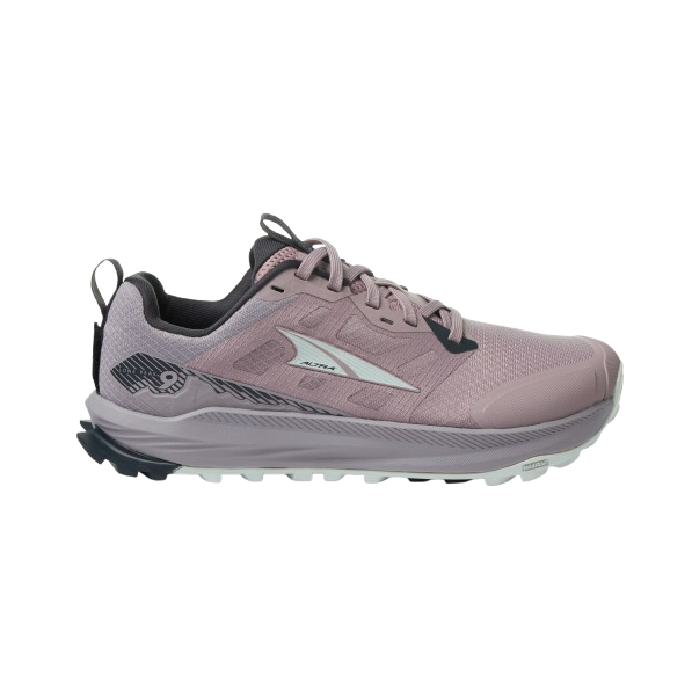
Women’s Altra Lone Peak 9
Best Hiking Shoes for Long-Distance & Thru-Hikers
CleverHiker Rating: 4.7/5.0
Price: $140
Weight (Pair): 1 lb. 3 oz.
Heel-to-Toe Drop: 0 mm
Pros
- Roomy toe box
- Cushion more responsive than previous models
- Ultralight
- Breathable
- No break-in needed
- Built-in gaiter attachment
- Wide sizes available
- Secure heel cup
- Perfect lace length
Cons
- Zero-drop takes some getting used to
- Not as cushioned as other trail runners
- Not as durable as some
- Not supportive enough for heavy loads
Like other Lone Peak models, the Altra Lone Peak 9 is one of our favorites when we want to go ultralight due to its low weight, grippy outsole, and roomy toe box. This iteration of the Lone Peaks hit the market with some improvements over the previous versions – the upper material is a more durable ripstop nylon, the outsole offers more foot protection, the overall design of the shoe is more sleek and streamlined, and the cushion is slightly firmer and more responsive.
If you’ve never tried an Altra shoe before, the first thing you need to know is that they are zero-drop, meaning your heel and toe sit at the same height in the shoe as opposed to having a higher heel. Trying these shoes on is a great start to see what drop height best fits your feet.
Lone Peak enthusiasts have been lamenting the downfall of durability since the Lone Peak 4.5s. However, the Lone Peak 9 sports a reinforced upper and more rugged outsole. Having said that, durability will always be part of the tradeoff when you want a lighter shoe. Yet, the combination of lightness and durability creates a standout shoe that is competitive with others on the market. The Lone Peaks are about as light as you can get for a long-distance shoe. Those seeking a low weight and a comfier fit that allows for natural movement should keep them at the top of their list.
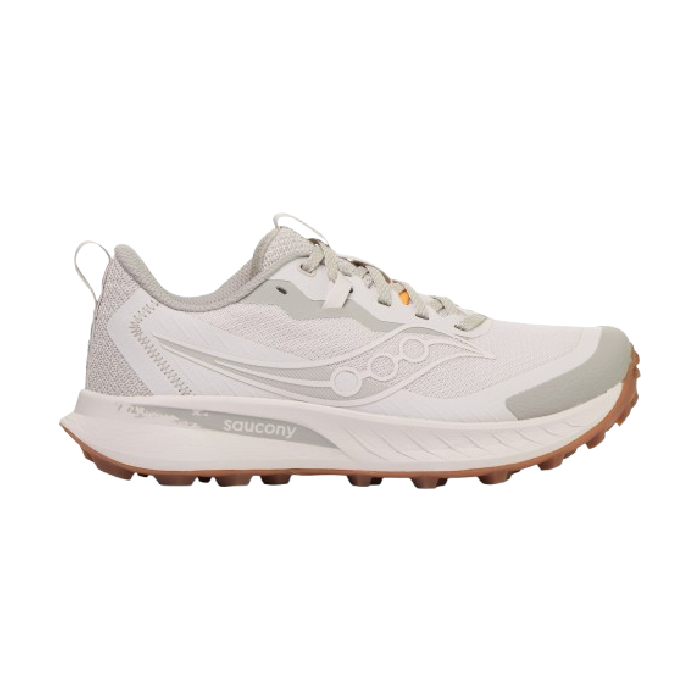
Women’s Saucony Peregrine 15
Best Lightweight Shoes for Hiking
CleverHiker Rating: 4.6/5.0
Price: $140
Weight (Pair): 1 lb. 1.2 oz.
Heel-to-Toe Drop: 4 mm
Pros
- Exceptional traction
- Less expensive
- Highly breathable
- Lightweight
- Very durable for the weight
- Wide sizes available
Cons
- Upper is a little stiff
- Fit is a bit narrow
The Saucony Peregrine 15 has exceptional traction and barely tip the scale at a super low weight. From trekking through the Sierras and tricky scrambling around Lake Tahoe, as well as traversing the rocky and muddy trails of Northern California, we found the sticky outsoles of the Peregrines to be up for any challenge.
The Peregrine 15s are just as light and even grippier than before with multidirectional 5mm lugs. The snug and secure fit makes you feel nimble and agile on the trail. They hold the foot well, protect against rolling ankles, and are perfect for tricky trails and uneven ground. The 15 has plenty of underfoot cushioning for tough terrain. Although they are made with a highly breathable engineered mesh upper that dries quickly, they don’t repel water well enough for adventures in inclement weather.
A shoe this light won’t be as durable as more traditional models in the long run, and the thin mesh upper doesn’t offer much protection, but you’ll expend less energy with each step and experience fewer problems with sweaty feet (like blisters). These shoes aren’t the best for carrying heavy loads, but we can’t recommend them highly enough for those who prefer lightweight trail runners.
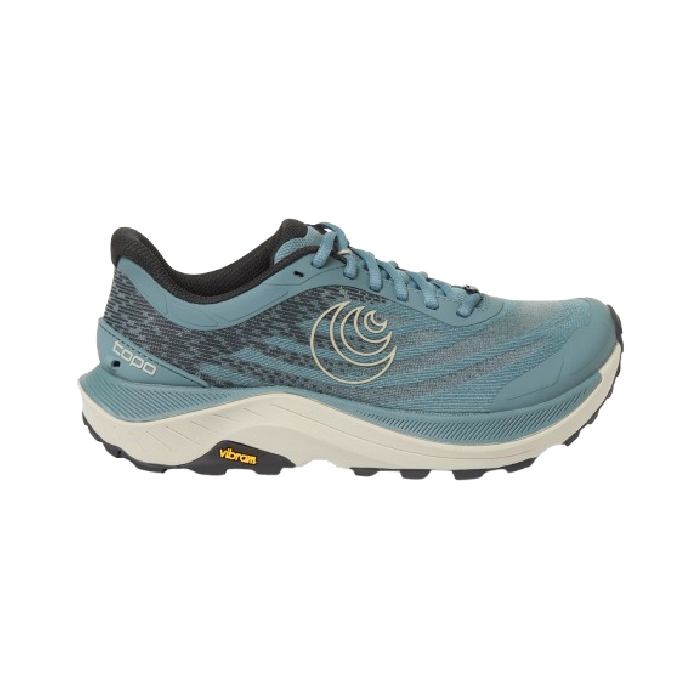
Women’s Topo Ultraventure 4
Best Hiking Shoes for Weight, Support & Breathability
CleverHiker Rating: 4.5/5.0
Price: $150
Weight (Pair): 1 lb. 0.6 oz.
Heel-to-Toe Drop: 5 mm
Pros
- Great price for the quality
- Roomy toe box
- Cushy soles
- Above-average comfort
- Lightweight
- Breathable
- Excellent traction
- No break-in needed
Cons
- Taller stack height can feel a bit unstable
- High volume & large toe box too roomy for some feet
The Topo Ultraventure 4s have quickly become a favorite hiking shoe for our team because they’re lightweight, highly breathable, and they have excellent grip on a variety of terrain types with their Vibram outsole.
The Ultraventures strike a nice balance between a natural foot shape and ample cushioning. We think they are a homerun for hikers looking for the ideal combination of lightweight trail runners and durable hiking shoes.
The uppers are flexible, light, and airy, so they’ll keep your feet cool and unrestricted on long hiking days. However, we’ve found that the taller stack height feels a bit unstable on tricky terrain. That said, the Ultraventures are plenty comfortable and secure for putting up big miles on established paths that don’t include sloped rock traverses or scrambling.
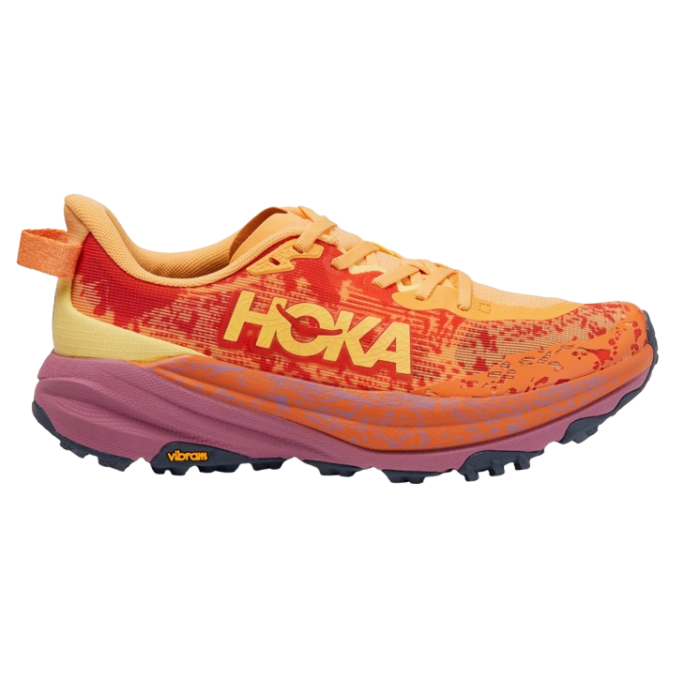
Women’s HOKA Speedgoat 6
Hiking Shoes with A Lot of Cushion
CleverHiker Rating: 4.5/5.0
Price: $155
Weight (Pair): 1 lb. 0.4 oz.
Heel-to-Toe Drop: 5 mm
Pros
- Very cushy soles
- Lightweight
- Excellent traction
- Roomy toe box
- Above-average comfort
- Breathable
- No break-in needed
- Hugs foot
Cons
- Can feel a bit unstable
- Large/bulky shoe
The HOKA Speedgoat 6 is known for its comfort and low weight. The standout feature of these shoes is the ultra-cushy midsole, which is excellent at absorbing impact and doesn’t flatten out as quickly as many other lightweight hiking shoes we’ve tested.
Thanks to that comfy design, the Speedgoats are a favorite among thru-hikers who need a lightweight shoe that can keep their feet and joints comfortable while logging lots of miles. These shoes are also more durable than many trail runners. The Speedgoat 6 uses more resilient CMEVA foam, making it more responsive and durable, while the 5 felt plusher. Still, we appreciate this update for resilience for longer days on the trail.
The updated Speedgoat 6 has a woven upper, so you get more mileage out of them, and more weather protection, but the more limited breathability may compromise comfort. We still found them to be a great summer shoe and did not find the more limited breathability to be drastically noticeable.
The dual-gusset tongue consists of two separate fabric panels stitched to the sides of the shoe’s tongue. These panels keep debris out of the shoes and reduce pressure points. It takes a second to get used to putting the shoe on, but afterward, this design point is a major bonus in terms of comfort and stability, as there is no tongue moving around, which means a more secure fit.
All that cushioning means the Speedgoats have a taller stack height, and this is where we find the limitation of these shoes. They can feel a bit unstable when carrying a heavy load, so we recommend getting your pack weight as low as possible before tackling big miles in these shoes. However, we still found the Speedgoats more supportive around the ankles compared to the Merrell Moab, for example, which, despite ample support underfoot, felt unstable on uneven ground.
The updated lugs provide excellent protection and traction on uneven terrain. The rockered sole is designed to keep you moving fast, and it does. With each step, the shoe springs you take another, keeping momentum and efficiency at their highest.
The Speedgoats are for hikers who need a cushioned ride and an uncompromising balance of low weight and durability.
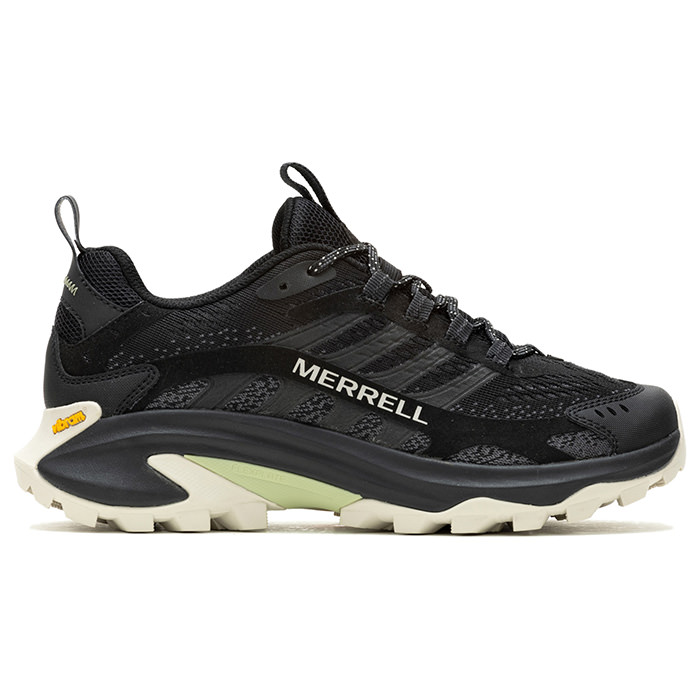
Women’s Merrell Moab Speed 2
Excellent for Style, Weight, & Durability
CleverHiker Rating: 4.4/5.0
Price: $140
Weight (Pair): 1 lb. 3.4 oz.
Heel-to-Toe Drop: 10 mm
Pros
- Lightweight
- Stylish
- Above-average comfort
- No break-in needed
- Excellent Traction
- Less Expensive
Cons
- Less cushioned
- Not supportive enough for heavy loads
Forget your previous assumptions about Merrells. The Moab Speed 2 is a whole different breed built for hikers who want to keep it light and fast while covering longer distances. Like a slimmed-down version of the traditional Moab 3 above, the Moab Speeds features a sleeker stout toe cap and a lighter heel. You’ll still get solid protection on rocky terrain – but the Speeds deliver it with a lighter and more streamlined build.
The Moab Speeds are a cross between a trail runner and a hiking shoe. They offer the lightness of a trail runner but some of the more elaborate protections of a hiking shoe, like a 10 mm heel-to-toe drop and rock plates, to help keep your foot comfortable on uneven terrain.
The Moab Speeds are more comfortable than many hiking shoe options on the market. During our test hikes in the Sierra Nevadas, we wore them for the rest of the day instead of switching to city shoes when back in town. However, the fit was quite large. Even with hiking socks, the sizing was much more generous than other brands. The broad and spacious fit felt less secure on uneven terrain, so we recommend sizing a half-size down.
We are also into the Moab Speeds’ appearance. They come in a variety of appealing colors, so you can wear them from town to the trail. For a high-quality shoe for day hiking that offers protection, support, comfort, and athletic style, the Moab Speeds are hard to beat.
There is no sticker shock with these kicks. The Moab Speeds are priced mid-range for a hiking shoe, and we think they are a great value. Those looking to do a longer hike with a heavier bag might want something with a tad more support, but these are a favorite for day hikes and light strike missions.
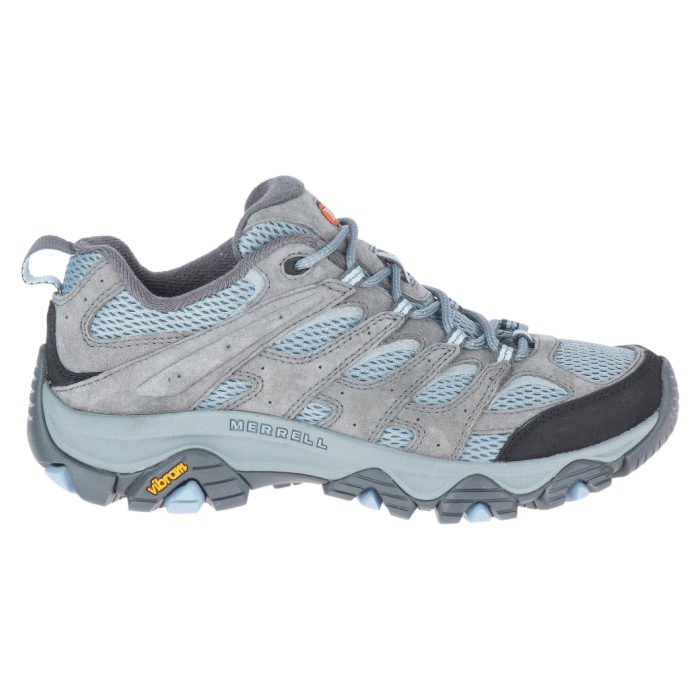
Women’s Merrell Moab 3
Best Budget Hiking Shoes
CleverHiker Rating: 4.4/5.0
Price: $120
Weight (Pair): 1 lb. 10 oz.
Heel-to-Toe Drop: 11.5 mm
Pros
- Lightweight
- Above-average comfort
- No break-in needed
- Less Expensive
Cons
- Not as durable as some
- Not supportive enough for heavy loads
For years, the Merrell Moab 3 has reigned supreme as our best budget hiking shoes due to its cushiony comfort, durability, and performance. Its relatively heavy and bulky design means it isn’t our first choice for big-mile days, but day hikers and those looking for a shoe that gives the protection of a boot without the restriction of a high collar will absolutely love these.
The upper is constructed with a combination of leather and mesh, which translates to an excellent balance of durability and breathability – especially compared to many full-leather waterproof designs typically found on more traditional hiking boots. The Moab 3s also come in a waterproof model. Still, the non-waterproof version’s breathability and decently quick drying time are generally more important to us than the added water protection. The shoe’s upper offers good protection during shallow water crossings, and no amount of waterproofing will keep moisture out during sustained downpours or deep water crossings anyway. The outsole uses Vibram TC5+ rubber for good grip on flat surfaces. However, like earlier models, the lugs are shallow, making the shoes less ideal for mud and loose terrain.
The Moab 3 remains a heavier shoe, comparable to its predecessors, which may feel bulky on longer hikes or for users looking for a more nimble option. But what the Moab 3s lack in style and grace, they more than make up for in cushioning and support. They also require less break-in than traditional shoes, which means you can get after those ambitious hikes right out of the box. If you’re after a burlier shoe that doesn’t compromise durability, traction, and comfort, the Moab 3s could be perfect for you.
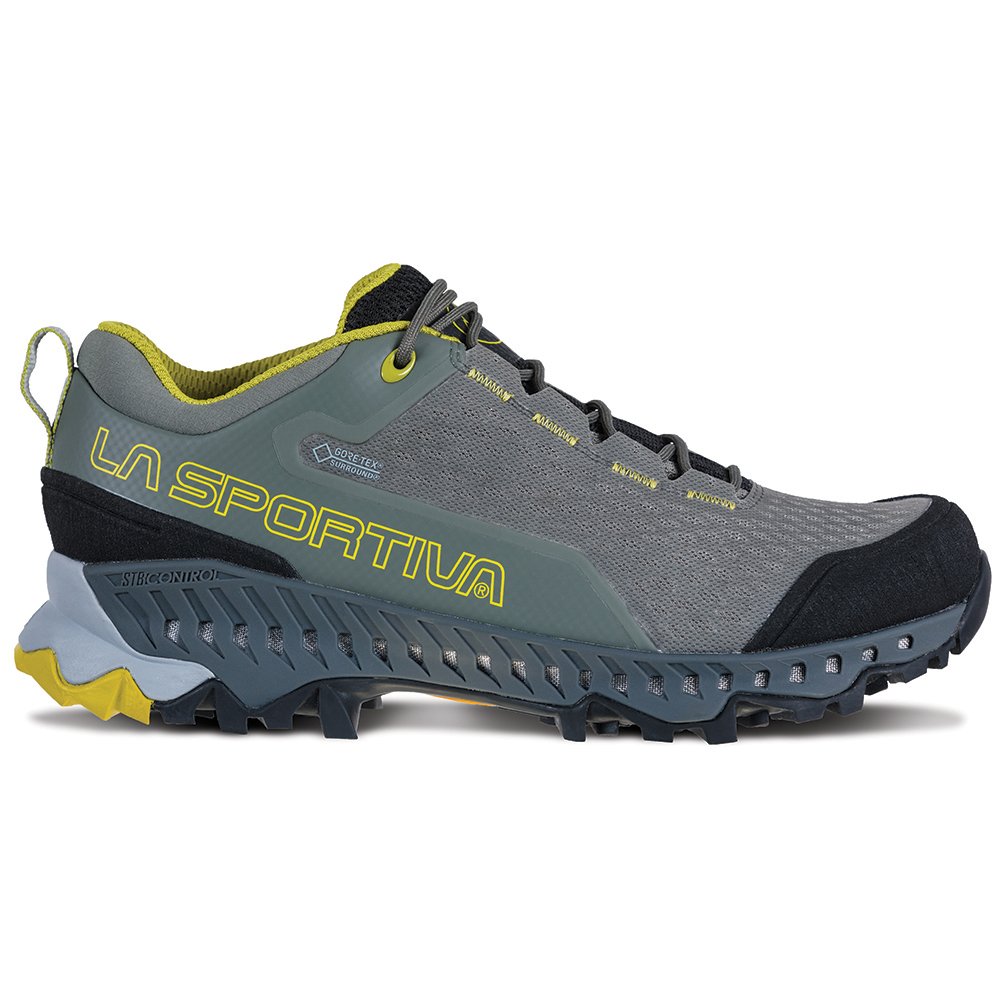
Women’s La Sportiva Spire GTX
Most Durable & Supportive Hiking Shoes
CleverHiker Rating: 4.3/5.0
Price: $209
Weight (Pair): 1 lb. 10 oz.
Heel-to-Toe Drop: 11 mm
Pros
- Superior traction
- Above-average support
- Exceptional durability
- Decently breathable for waterproof shoes
- Cleaner look than other burly hiking shoes
Cons
- Expensive
- On the heavier side
- Some break-in required
- A bit stiff
The La Sportiva Spire GTX are what we reach for when we need maximum traction and stability on technical terrain. We really put these shoes through their paces on recent hikes among the granite mountains of Southern Arizona, and they delivered exceptional protection and grip from trailhead to peak.
What stands out most about the Spires is their boot-like performance in a more nimble package. With a high level of support and durability but a streamlined fit and look, it’s not surprising to us that La Sportiva describes these as a low-cut boot. This beefy build contributes to a higher overall weight for the Spires, but we don’t find them uncomfortably heavy thanks to the balanced design.
Backpackers hiking with a heavier pack weight in the 35+ pound range will find these shoes well-suited to support a heavy load. However, those traveling a bit lighter may prefer to forego the substantial cost of the Spires by choosing a more flexible and affordable option. The Spires undoubtedly provide ample support and traction.
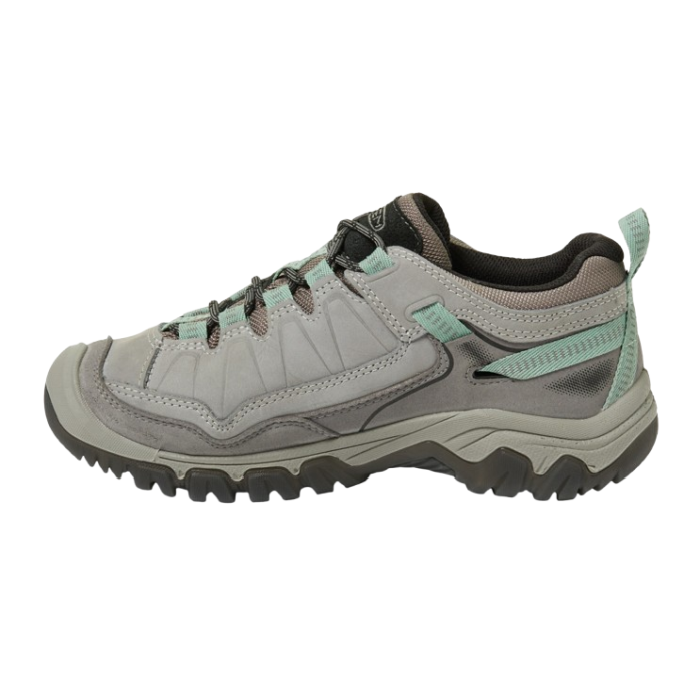
Women’s KEEN Targhee IV WP
Excellent Value Hiking Shoes for Day Hikers
CleverHiker Rating: 4.2/5.0
Price: $160
Weight (Pair): 1 lb. 15.5 oz.
Heel-to-Toe Drop: 14 mm
Pros
- Roomy toe box
- Great traction on non-technical trails
- Extra secure lacing system
- Durable
- Waterproof
Cons
- On the heavier/bulkier side
- Stiff soles
- Waterproofing limits breathability
- Requires longer break-in period
The KEEN Targhee IV WPs are a favorite because they’re a dependable shoe that’s made to last. These leather hiking shoes require a longer break-in time than many of the lightweight models on our list, but the high-quality material of the upper holds up for hundreds of miles on the trail.
One of our favorite features of the Targhees is the elastic band that connects the laces to the heel cup. This provides a secure, locked-in feeling and makes it easier to dial in the perfect fit. The Targhees are also known for their wide toe box, so they’re an excellent choice for hikers needing a little extra wiggle room in their shoes.
Because they’re on the bulkier side and not as breathable or fast-drying as some shoes, we recommend the Targhees for shorter hikes and for those who want something long-lasting and comfy for daily wear.
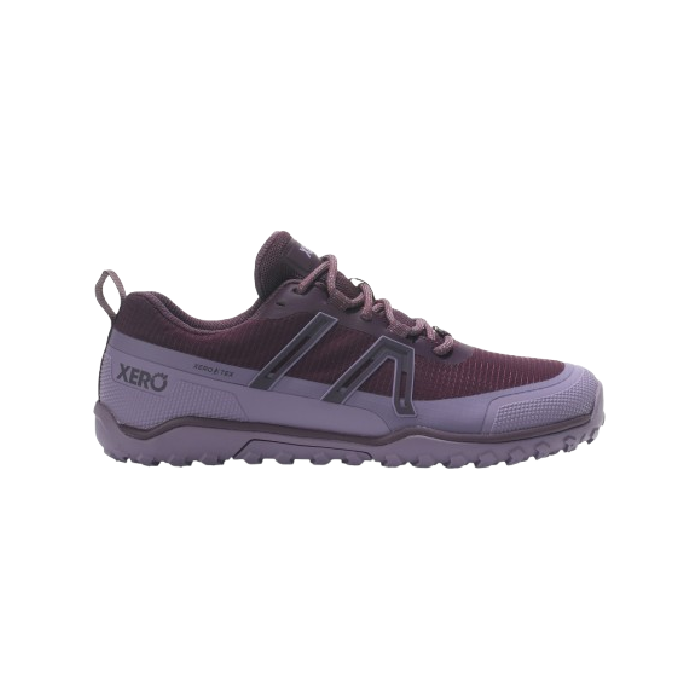
Xero Shoes Scrambler Low Trail WP
Solid Minimalist Hiking Shoe
CleverHiker Rating: 4.1/5.0
Price: $150
Weight (Pair): 1 lb. 3.2 oz.
Heel-to-Toe Drop: 0 mm
Pros
- Natural foot shape
- Excellent ground feel
- Breathable
- Perfect for minimalist runners & hikers
Cons
- May not provide enough cushion
- Does not shed mud well
The Xero Shoes Scrambler Trail Low WP are an excellent option for minimalist and barefoot hiking enthusiasts. They provide a decent balance between ground feel and light cushion, making them a versatile option.
They feature a rugged outsole with large lugs for better traction as well as a waterproof membrane and gusseted tongue to protect from the elements. However, we would like to see better grip in wet conditions as well as lugs that are more capable of shedding mud.
We love how lightweight and flexible this shoe is. With their zero-drop design and natural foot shape, they offer one of the most flexible soles in our lineup and stand out as an alternative for those Altra fans who desire more ground feel.
Our feet felt secure in the heel cup, though we did find that the laces came untied fairly easily – so double-knotting is important. We also found that the upper is a bit stiff and uncomfortable at the toe joint, though this may not be as noticeable depending on your particular foot volume and shape.
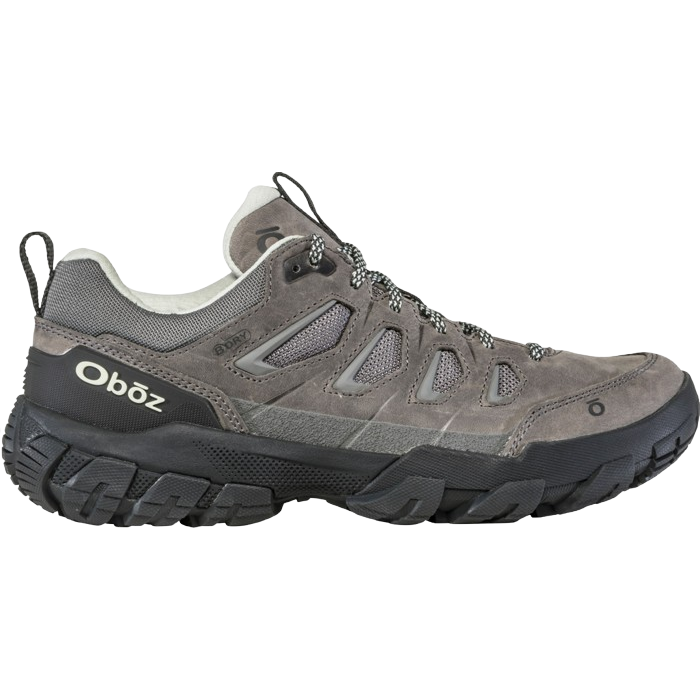
Women’s Oboz Sawtooth X WP
Highly Supportive Hiking Shoes That Hold Up to Hard Use
CleverHiker Rating: 3.8/5.0
Price: $165
Weight (Pair): 1 lb. 12.2 oz.
Heel-to-Toe Drop: 8 mm
Pros
- Exceptional durability
- More supportive than most hiking shoes
- Excellent traction
- Wide toe box
- Surprisingly quick break-in for such a stout shoe
- Waterproof
- Wide sizes available
Cons
- Heavy/bulky
- Support is overbuilt for some
- Waterproofing limits breathability
Thanks to their signature premium insoles, the Oboz Sawtooth X WP are some of the most supportive hiking shoes we’ve tested. The molded arch and heel cup, cushy midsoles, and exceptional traction make this shoe a great choice for challenging terrain – especially for backpackers who tend to carry heavier loads over 40 pounds.
The Sawtooths have been a star in Oboz’s lineup of trail shoes for years, and this tenth anniversary edition stays true to the heart of the original while improving upon some key performance features. The reimagined midsole is more durable and supportive, and the outsole has stickier rubber with a new lug pattern for better traction on variable terrain.
The traditional-style Sawtooths start a little stiffer than other pairs, so we recommend breaking them in before taking them on any big trips. But after you get past this initial period, you’ll have a comfy shoe that can withstand multiple years of hiking.
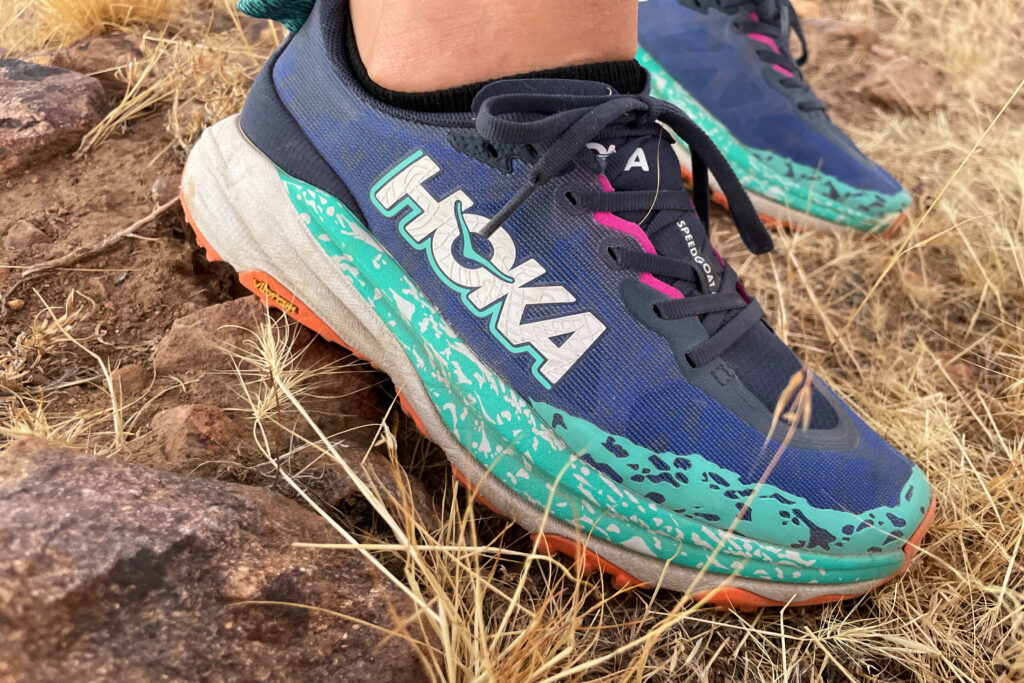
Product Comparison Table
| oSort | Product | Price | Weight (Pair) | Heel-to-Toe Drop | Comfort | Traction | Weight Score | Durability | Weather Resistance | 0 |
Salomon X Ultra 4 Low View at REI View at Amazon |
$140 | 1 lb. 6.4 oz. | 11 mm | 4.8 | 4.9 | 4.3 | 4.7 | 4.5 | 1 |
Altra Lone Peak 9 View at REI View at Amazon |
$140 | 1 lb. 3 oz. | 0 mm | 4.7 | 4.5 | 4.7 | 4.0 | 3.8 | 2 |
Saucony Peregrine 15 View at REI View at Amazon |
$140 | 1 lb. 1.2 oz. | 4 mm | 4.6 | 4.7 | 4.9 | 4.0 | 3.6 | 3 |
Topo Ultraventure 4 View at REI View at Amazon |
$150 | 1 lb. 0.6 oz. | 5 mm | 4.8 | 4.5 | 4.9 | 4.2 | 4.0 | 4 |
HOKA Speedgoat 6 View at REI View at Backcountry |
$155 | 1 lb. 0.4 oz. | 5 mm | 4.3 | 4.6 | 4.9 | 4.6 | 4.5 | 5 |
Merrell Moab Speed 2 View at REI View at Amazon |
$140 | 1 lb. 3.4 oz. | 10 mm | 4.5 | 3.9 | 4.5 | 4.0 | 3.7 | 6 |
Merrell Moab 3 View at REI View at Amazon |
$120 | 1 lb. 10 oz. | 11.5 mm | 4.5 | 4.3 | 3.8 | 4.0 | 4.4 | 7 |
La Sportiva Spire GTX View at REI View at Amazon |
$209 | 1 lb. 10 oz. | 11 mm | 4.0 | 4.8 | 3.8 | 4.8 | 5.0 | 8 |
KEEN Targhee IV WP View at REI View at Amazon |
$160 | 1 lb. 15.5 oz. | 14 mm | 4.1 | 4.2 | 3.6 | 4.8 | 4.8 | 9 |
Xero Shoes Scrambler Low Trail WP View at REI View at Amazon |
$150 | 1 lb. 3.2 oz. | 0 mm | 3.7 | 3.8 | 4.5 | 4.0 | 4.8 | 10 |
Oboz Sawtooth X WP View at REI View at Amazon |
$165 | 1 lb. 12.2 oz. | 8 mm | 4.0 | 4.6 | 3.7 | 4.8 | 4.7 |
|---|
How We Test & Methodology
We assess hiking shoes using five dimensions: comfort, traction, weight, durability, and weather resistance. We have hiked hundreds of miles in each pair of shoes and taken them the distance to determine how each model performs in the following metrics.
COMFORT
Comfort is essential when it comes to footwear. We test with particular attention to the toe box, ensuring there is enough space to accommodate natural toe splay and swelling. However, we also want to be sure that the toe box is not so wide that it feels unstable on challenging terrain.
We scrutinize the lacing system and the heel cup, looking for a secure and customizable fit that allows users to adjust tension over a hike and prevent slippage or pressure points. The right sole stiffness is crucial to balance stability and flexibility, depending on what kind of terrain you expect to be hiking.
We look for sufficient support that allows for protection on uneven terrain, including each shoe’s ability to support various foot arch types to limit fatigue and discomfort over extended periods. We also feel for cushioning and a shoe’s capacity for impact absorption and responsiveness. When testing comfort, we also consider the heel-to-toe drop of the shoe, where lower drop shoes tend to have a more natural fit and feel.
TRACTION
For traction, we tackle traditional single track to gravel, rock scrambles, mud, exposed roots, and sand. Most shoes perform admirably enough in fair conditions, so we trudge each pair through wet and slick conditions to figure out which ones can really grip in the muck. We analyze the lug pattern of the outsole and rank them by depth and bite. Deeper lugs typically provide superior traction in loose or slippery conditions. The sole material plays a vital role in traction performance. We also test out additional traction features like heel brakes and forefoot grooves, which generally enhance grip and maneuverability on steep descents or ascents.
WEIGHT
The lighter, the better, right? We think so. Lighter shoes prevent fatigue and increase agility and speed. With the incredible materials and designs on the market, a heavier hiking shoe doesn’t always mean more support.
Though some hikers still prefer the feeling of heftier materials, which can sometimes offer more protection and durability on the trail. Our favorite hiking shoes range from just over a pound to just over two pounds to accommodate a variety of hikers’ preferences. We look at the listed manufacturer’s weight and also weigh each pair ourselves.
DURABILITY
We examine durability in every aspect, from construction to materials that ensure long-lasting performance on the trail. We put in mile after mile, carefully assessing the outsole material, opting for durable toes and specialized upper blends that resist abrasion and wear.
We also feel out the insole foam to see how well it maintains its cushioning properties and structural integrity over extended use. The upper material is a critical consideration for us. The upper can compromise foot stability, and we examine its resilience against tears and punctures, especially in high-wear areas.
And though they are replaceable, we still scrutinize the durability of the laces, ensuring they can withstand repeated tightening and loosening without fraying or breaking.
WEATHER RESISTANCE
Weather resistance is mainly about keeping out water, but also involves the ability to dry quickly and provide adequate breathability. Weather resistance is about keeping out water, drying quickly, and providing breathability to keep feet dry. After hiking through rain and crossing waterways, we thoroughly examine the upper material of each pair for its ability to repel water.
Certain features like well-sealed seams and a gusseted tongue are important for their effectiveness in preventing water penetration. In addition, we pay attention to the design of the collar, looking for a snug (but still comfortable) seal against rain, mud, and debris. Furthermore, we assess the breathability of the shoe to prevent sweat buildup in how weather and assess how fast they dry.
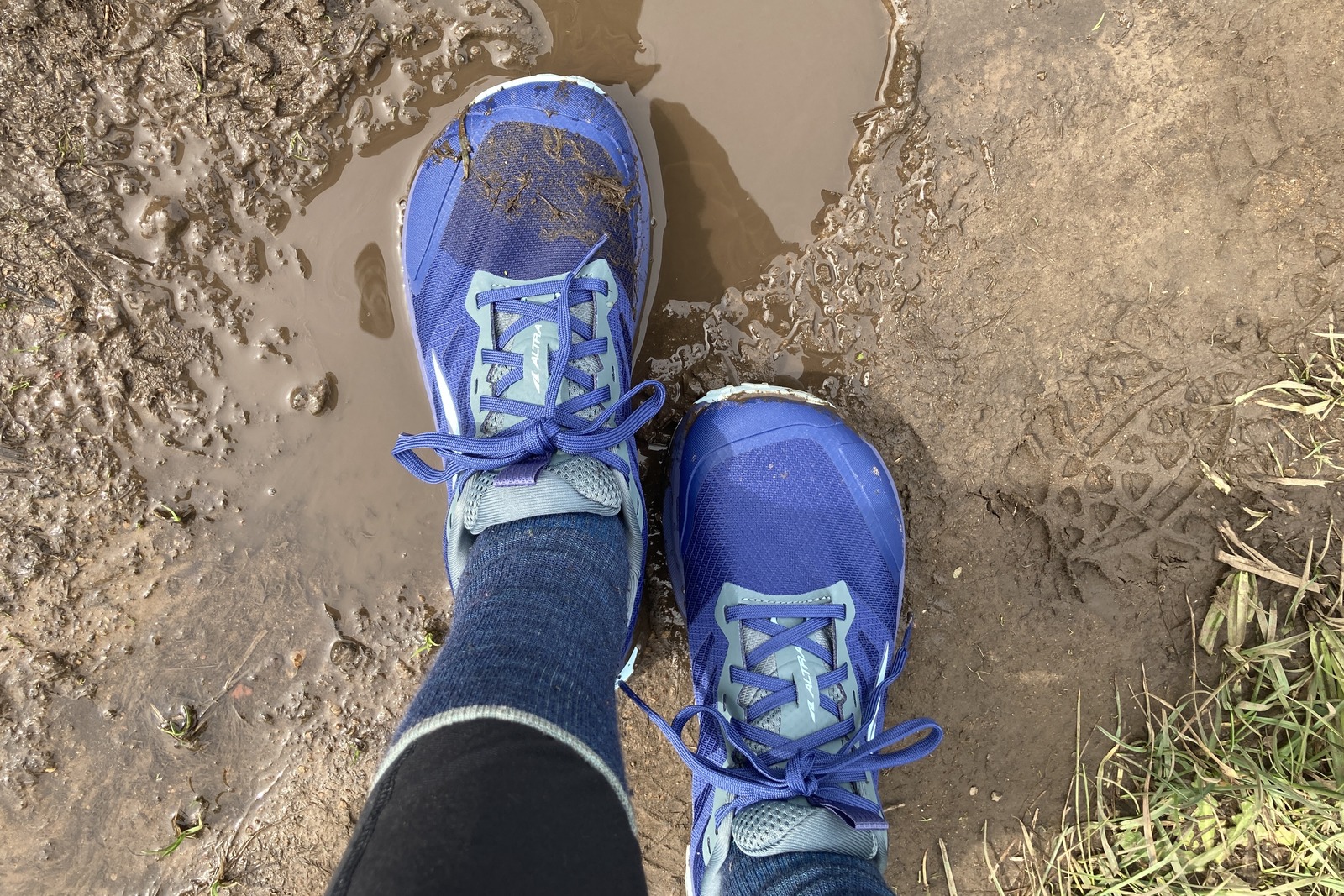
Why Trust CleverHiker
The CleverHiker team has an expert eye for outstanding hiking shoes; we’ve spent more than 20,000 miles hiking and trekking to find the best models for every hiker.
Gear Analyst Alice Hafer has conquered thousands of miles across the world from the Appalachian Trail to the French Alps, while Emily Parnay has meticulously tested women’s hiking shoes from the mountains to the sea in the Western US. With countless swollen knees, battered ankles, and sore feet, their assessments after hiking through mud, snow, rain, and blazing sun on some of the toughest trails in the world guarantee that only the best footwear earns a spot on our list.
With extensive experience in the outdoor industry, their deep knowledge of footwear means that their recommendations come straight from the source.
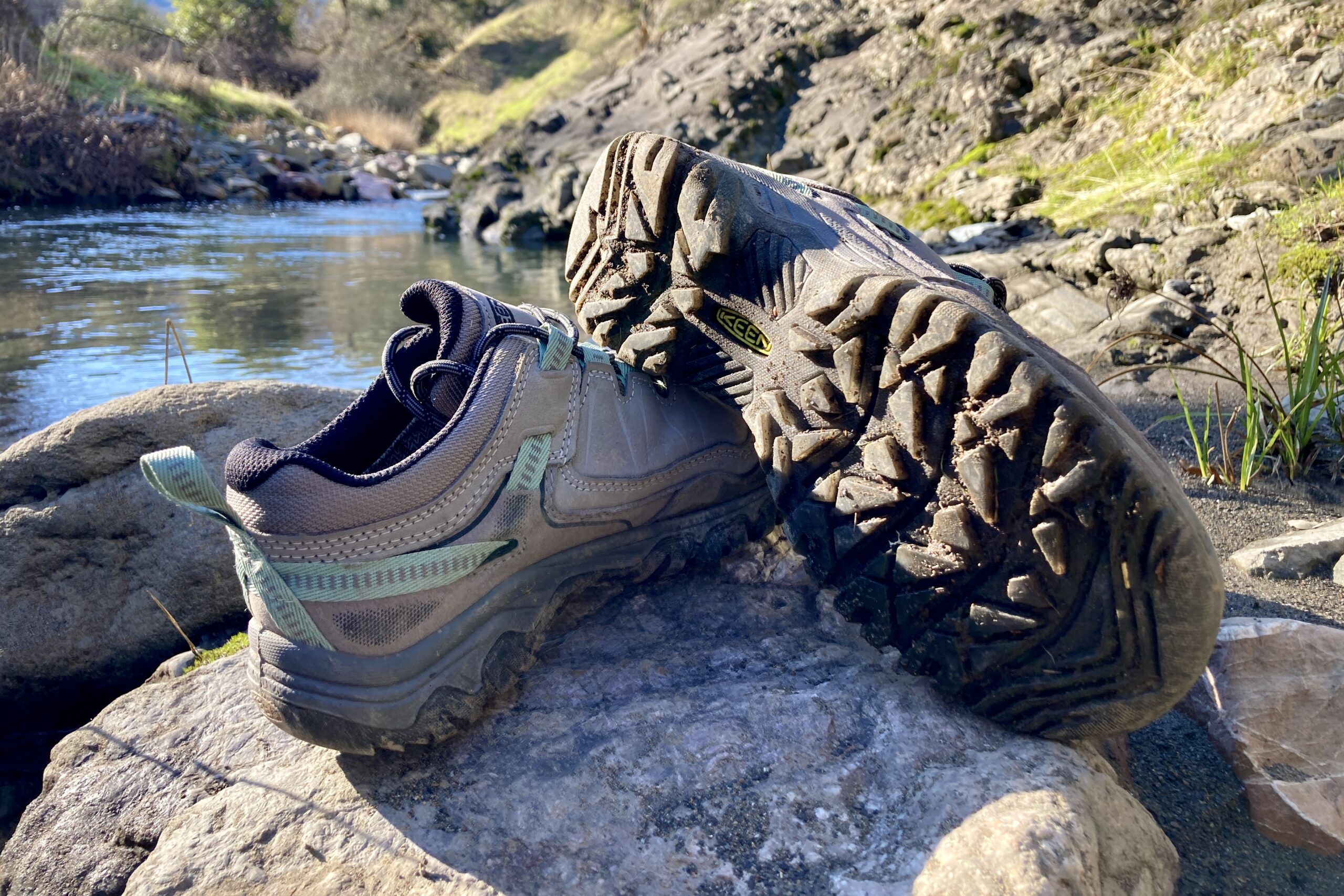
Analysis & Results
Tighten those laces and scroll down to find out which hiking shoes are the top performers for comfort, traction, weight, durability, and weather resistance.
VALUE
High-quality hiking shoes can be expensive, but they’re one of the most important investments you’ll make. Keeping your feet happy and healthy on the trail is the foundation for a good day (or month) out hiking. Not only do we assess performance, but we look for great value. The better performance a product has relative to its price, the greater its value.
If you’re looking for premium shoes without the premium price, our top performers are the Merrell Moab 3, Altra Lone Peak 9, and the Saucony Peregrine 15. Each of these models is an excellent choice for hiking thanks to high-quality outsoles that offer unrivaled durability and superior traction.
The Merrell Moab 3s are your trusted workhorses built for comfort and protection. The Altra Lone Peak 9 are your go-to for thru-hikes where you need toe box comfort and prefer your natural gait. The Saucony Peregrine 15 is your best friend for swift trail running days and technical speed missions. These are also some of the most comfortable options on our list, with cushy midsoles, superior grip, and ergonomic designs that support the foot according to varied fit preferences (from 10 mm heel-to-toe drop to zero-drop) during long hikes to reduce fatigue, promote natural foot flexion, and prevent discomfort.
COMFORT
The most comfortable shoes we tried are the Salomon X Ultra 4 Low, Altra Lone Peak 9, and the Topo Ultraventure 4. The Salomon X Ultra 4 offers a responsive midsole that effectively absorbs impact and keeps your feet feeling fresh after long hiking days. Its lightweight design has a snug and secure heel cup, yet generous toe box which can be easily customized to your feet with the quick-lace system. Even in its non-waterproof version, we found it to resist moisture effectively.
We’re big fans of the Altra Lone Peak 9, with its out-of-the-box comfort thanks to a natural foot shape and streamlined fit. The heel cup is snug, the lacing system adequately secures your foot, and the new firmer, more responsive cushioning provides longer-lasting comfort balanced with decent ground feel. The durable outsole and integrated stoneguard provide additional protection on the trail.
And, you can’t go wrong with the Topo Ultraventure 4. This model has one of the widest toe boxes on this list, so your toes and forefoot can splay and flex naturally, reducing discomfort and the potential for blisters. Its soft EVA midsole provides plush cushioning and responsiveness, and the breathable mesh upper and gusseted tongue make this one of our top choices for hot days since it’s so breathable with the lacing system offering a reliable, strong fit.
TRACTION
The top performers for traction are the Salomon X Ultra 4 Low, Saucony Peregrine 15, and the La Sportiva Spire GTX. All three models are equipped with aggressive, multi-directional lugs on their outsoles that bite into the ground effectively – whether it’s mud, rocks, or loose gravel. Robust lug patterns like these models make them stable and reduce the risk of slipping.
Each one uses durable rubber blends in their outsoles and proprietary materials that are incredibly abrasion-resistant and long-lasting, so the lugs maintain their grip over the life of the shoe. Plus, each shoe offers a supportive midsole construction that makes them feel simultaneously responsive and stable, which directly translates to better control and traction on uneven terrain. We also have to give honorable mentions to the Topo Ultraventure 4, Altra Lone Peak 9, Oboz Sawtooth X Low, and HOKA Speedgoat 6 as these shoes still offer excellent traction overall.
WEIGHT
The lightest shoes on our list are the Saucony Peregrine 15, Altra Lone Peak 9, Topo Ultraventure 4, and Xero Shoes Scrambler Trail Low WP. These models offer varying levels of support, so you’ll feel comfortable and stable – without feeling weighed down. These shoes lead the pack when it comes to breathable materials for ventilation, flexible outsoles for top-tier ground contact, shock-absorbing midsoles for added comfort, and ergonomic designs that promote natural foot movement. Just because they’re lightweight, though, doesn’t mean they aren’t durable.
These models are impressively versatile and feature excellent construction for added longevity. The Saucony Peregrine 15 and Topo Ultraventure 4 weigh around 1 lb. 1 oz. The Saucony Peregrine 15 boasts lightweight mesh and synthetic overlays in the uppers, which makes it airy without unnecessary bulk. The Topo Ultraventure 4 is like walking on air with its breathable upper and thicker cushioned stack height. The Altra Lone Peak 9 uses similar advanced materials and a zero-drop midsole that offers ample cushioning while keeping the overall weight low.
And, rounding out our top four for weight is the Xero Shoes Scrambler Trail Low WP, weighing in at just 1 lb. 3.2 oz. This barefoot and minimalist shoe utilizes lightweight construction to support optimized ground feel and weather resistance.
DURABILITY
If your top priority is durability, look no further than the Oboz Sawtooth X WP, KEEN Targhee IV WP, Salomon X Ultra 4 Low, and the La Sportiva Spire GTX. These shoes share features like reinforced toe caps, abrasion-resistant uppers, durable, grippy outsoles, quality water resistance, and robust construction.
Additionally, the KEENs, Oboz, and La Sportiva feature high-quality and effective waterproof membranes like Oboz’s B-DRY and Gore-Tex, which protect against the elements and extend the shoes’ lifespan. The Oboz Sawtooth X WP is our top pick due to its sturdy leather and mesh upper and outstanding, burly lug pattern built to last season after season. Similarly, the KEEN Targhee is a hefty shoe that is built to last with its thick leather upper and rugged outsole.
Alternatively, the Salomon X Ultra 4 Low has a synthetic upper that’s seriously abrasion-resistant, but it also stands out thanks to long-lasting details like excellent water resistance (even without a waterproof membrane), tall and soft heel cuffs, and a large toe cap. The La Sportiva Spire GTX rounds out our top picks with its rugged Vibram outsole and burly upper, offering excellent resistance to wear and tear.
WEATHER RESISTANCE
For weather resistance during wet, snowy, and muddy adventures, our top picks are the Oboz Sawtooth X WP, La Sportiva Spire GTX, KEEN Targhee IV WP, and Xero Shoes Scrambler Trail Low WP. These models share features that make them exceptional when the clouds roll in, like high-quality waterproof membranes, seam-sealed construction, protective uppers, and moisture-wicking linings.
They all offer rugged outsoles that offer excellent traction on wet and slippery surfaces as well. The Oboz Sawtooth X WP features the Oboz B-DRY waterproof membrane, which will keep your feet dry and still allow for excellent breathability thanks to their combination of leather and mesh in the upper.
La Sportiva Spire GTX utilizes Gore-Tex Surround technology, which provides 360-degree waterproofing and breathability. The KEEN Targhee IV WP incorporates the brand’s own KEEN.DRY waterproof membrane, effectively sealing out moisture while allowing for air circulation. Finally, the Xero Shoes Scrambler Trail Low WP consists of their XeroTex membrane to keep your feet dry from both sweat and the outside elements.
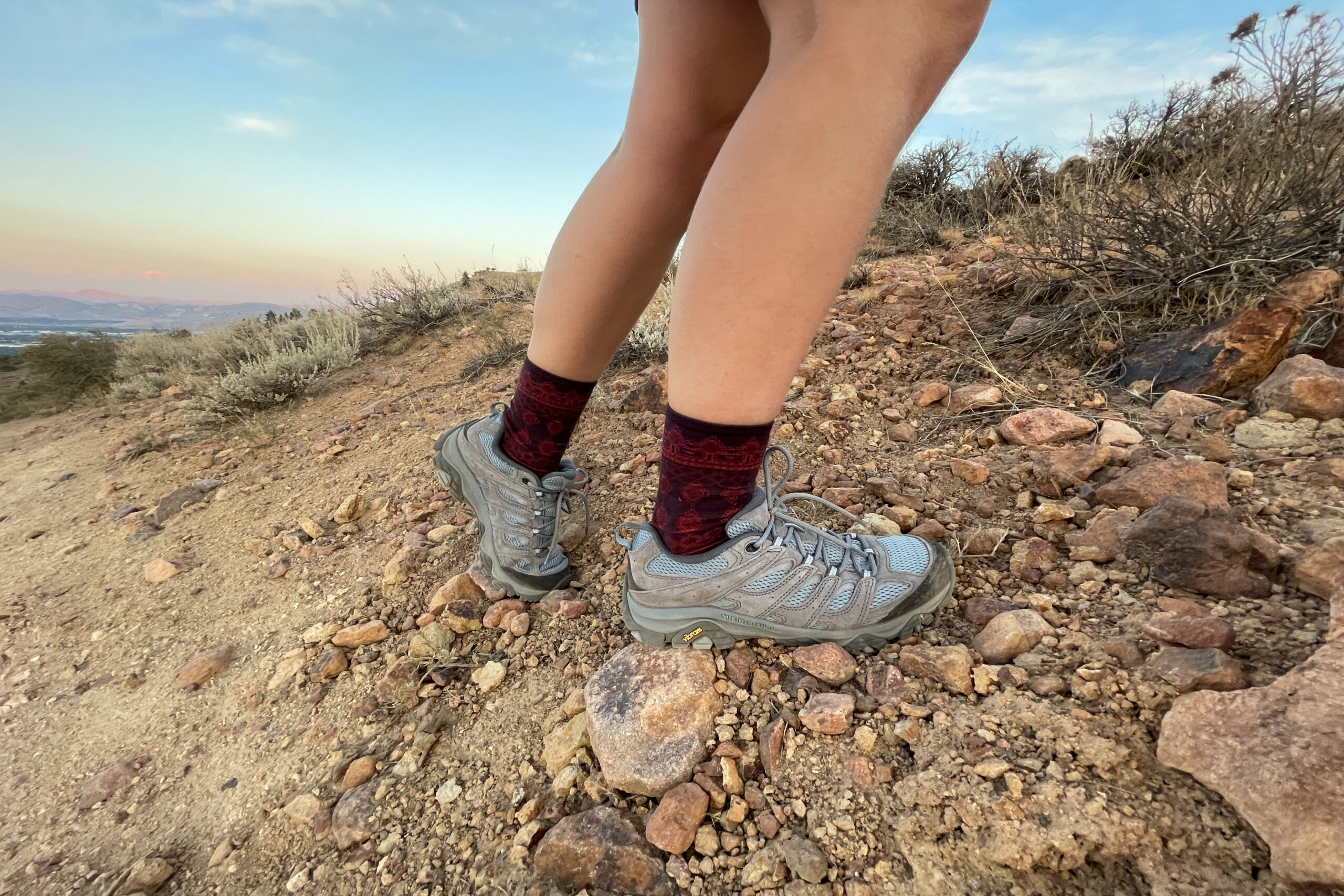
How to Choose Hiking Shoes
Choosing a comfortable, yet effective hiking shoe is paramount to a successful adventure. Everyone’s feet are different and we have individual needs and preferences for drop height, cushion, and stability features. Below we provide you with some guidance on how to find the best shoe for your feet.
BOOTS VS. SHOES VS. TRAIL RUNNERS
As you are searching for your perfect shoe, it is important to consider its main purpose and intended use. If you are a trail runner who does a mix of running and hiking, we suggest that you focus on lightweight trail runners. Trail runners are versatile options that can also be used for daily hiking, yet give you the freedom to also pick up the pace comfortably.
Further, if you are planning on extended backpacking trips, you may want to consider more durable and heftier shoes that provide additional support for carrying heavier loads. However, if you are just looking for a casual daily hiker, then comfort is the most essential factor to take into account.
Lastly, if you plan on doing a lot of technical hiking, such as peak scrambling where precision in each step is essential, we suggest prioritizing form-fitting, nimble, and lightweight shoes that boast unparalleled traction. For technical climbs and hikes, avoid bulkier shoe models or those that feel too large and roomy, which can lead to instability on challenging terrain.
SIZING
Feet can swell during long days on trail, so it’s a good idea to buy hiking footwear at least a half size larger than your normal shoes if you’re on the edge of a size. A good way to test sizing on your hiking shoes is to loosen all the laces, situate your foot so that your toes touch the front of the toe box, and then make sure you can put your index finger between your heel and the back of the shoe. This will ensure that your toes don’t slide forward and hit the toe box on downhill sections of trail. You should also consider which socks you’ll be wearing and if you’ll be adding aftermarket insoles when choosing a size. It’s much better for footwear to be a little big than too small.
BREAK-IN PERIOD
You’re going to take thousands of steps on any backpacking or hiking trip, so you need to know that your footwear will fit comfortably and won’t cause blisters. We recommend buying your footwear at least a few weeks before any long hiking trips and spending as much time in them as you can. This will allow your new shoes to soften up, and you can make sure they work well for your feet. If you notice any issues, it’s much easier to address them before you head into the backcountry.
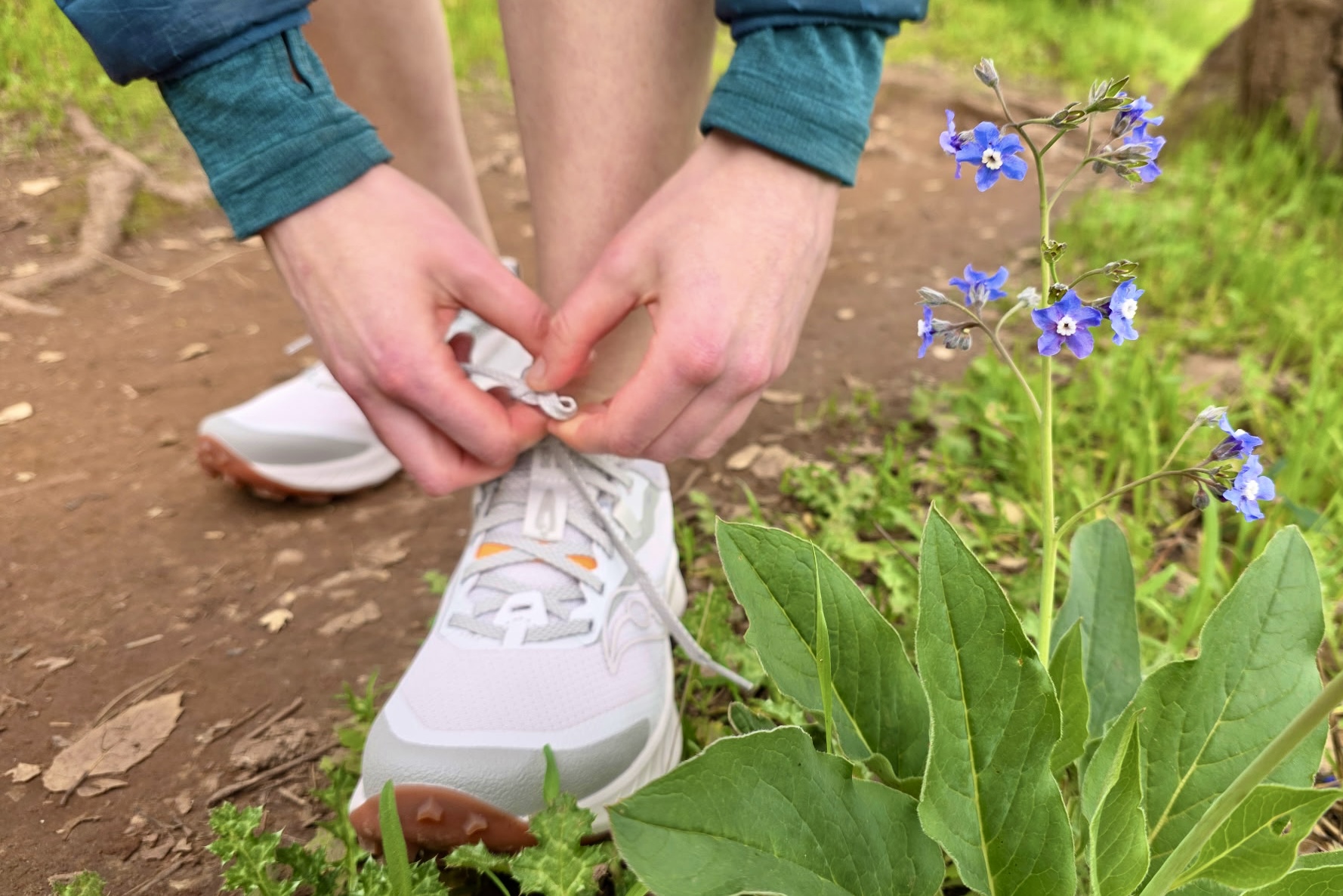
TRACTION
Traction is one of the most important aspects of backpacking and hiking footwear. Your shoes will take you over narrow and rocky ridgelines, through slippery water crossings, and across loose scree fields. Knowing that your footwear will keep you from slipping is crucial, especially over washed out or exposed sections of trail. We heavily factored quality traction into all of our footwear recommendations.
MANAGING MOISTURE & BLISTERS
If you’re on an extended trip in wet conditions or you find yourself caught in a downpour during a day hike, your feet will likely get wet no matter what type of footwear you’re wearing. Wet feet can lead to hot spots and blisters, but this can be prevented if you have a healthy foot care routine. Whether you hike in waterproof hiking shoes or non-waterproof trail runners, be sure to check out our post on How to Prevent and Treat Blisters for more info on moisture and blister management.
WATERPROOFING TREATMENTS
When selecting your hiking shoes, it’s important to consider your need for waterproofing. While waterproof shoes can protect your feet from rain, creek crossings and wet meadows, they also take longer to dry if water does get inside of the shoe. This is an important consideration depending on the environment where you plan to spend most of your time hiking.
While waterproof membranes keep you dry from the elements, they don’t always keep your feet dry from sweat. Oftentimes, lower quality waterproofing traps air and sweat inside your shoes, leading to blisters. It’s important to look for high quality waterproofing systems in your shoes, such as Gore-Tex, which offer a great balance of breathability and weather resistance. If hiking in primarily hot and wet environments, this is especially very important!
As you’re looking at different waterproof materials, we encourage you to look for those made without PFAs (aka forever chemicals), which appear in many water repellent products, including the waterproof membranes in some hiking shoes. These chemicals leach out of the material in wet conditions and contaminate the environment. Many U.S. states have their own restrictions for PFAs which have nudged brands to phase them out, however, there is currently no federal ban for these chemicals in outdoor apparel and gear.
SOCKS
We’ve found that wearing quality socks makes a big difference in how long we can keep our feet happy and in good shape on trail. Hiking socks should be comfortable, durable, and made with materials that wick moisture away from your skin. Check out our Best Hiking Socks list to see our top picks.
INSOLES
Aftermarket insoles can help alleviate a variety of shoe discomforts on the trail. If you suffer from plantar fasciitis or you just need more cushioning and support in an otherwise rigid shoe, swapping insoles may be your solution. Insoles can also help take up a little extra space in footwear for a customized fit if you’re between sizes.
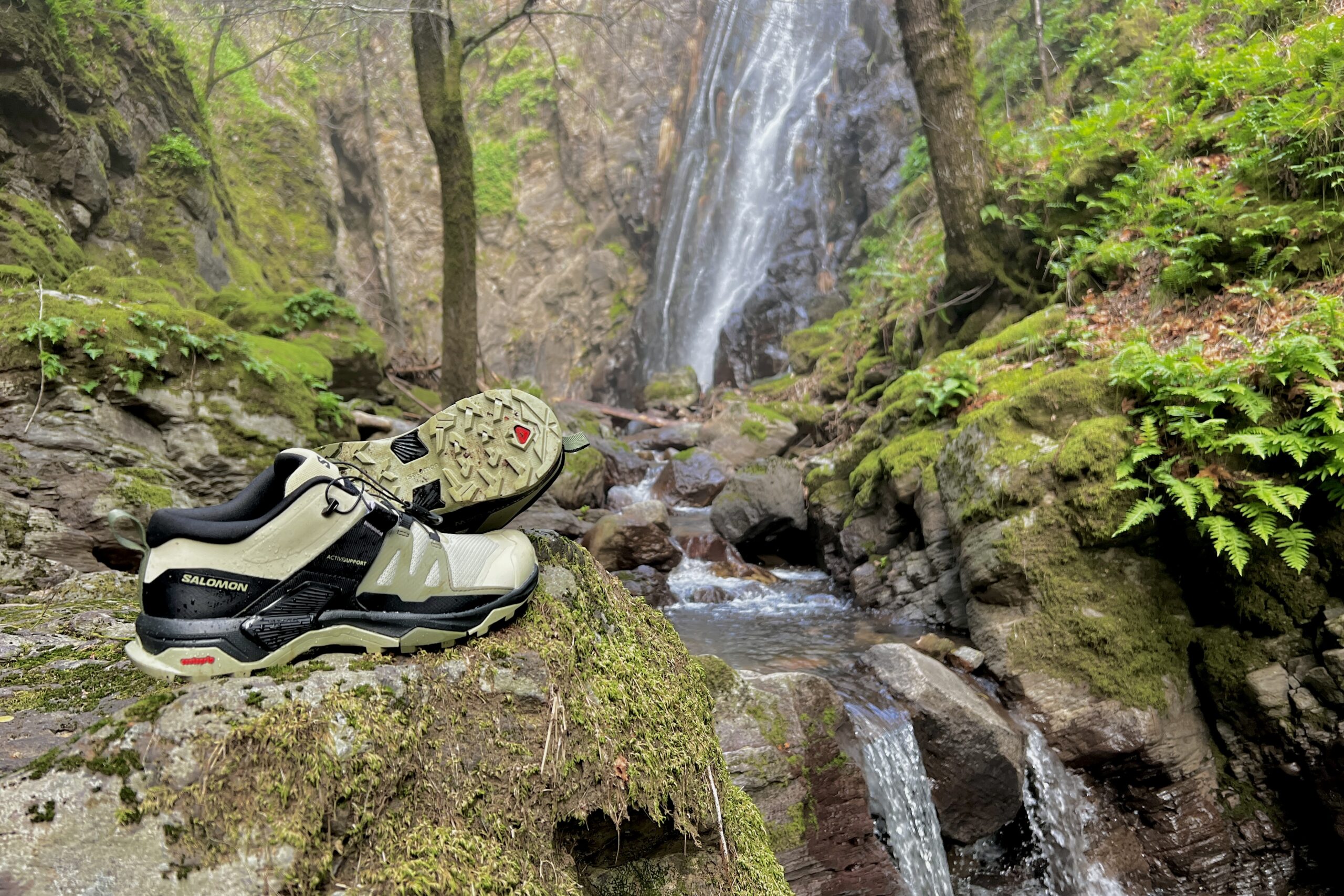
Conclusion
We hope this guide to the best women’s hiking shoes elevates your hiking experience, helping you tackle long miles and ambitious adventures. Shoes that excel in comfort, traction, weight, durability, and weather resistance can transform your time on the trail, making every hike more enjoyable and memorable.




